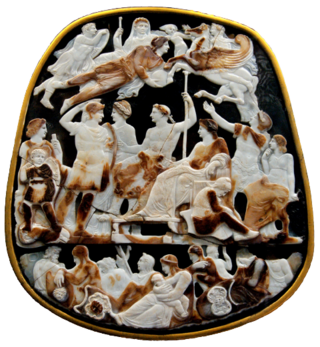
Julia Agrippina, also referred to as Agrippina the Younger, was Roman empress from 49 to 54 AD, the fourth wife and niece of Emperor Claudius, and the mother of Nero.

The Julio-Claudian dynasty comprised the first five Roman emperors: Augustus, Tiberius, Caligula, Claudius, and Nero.

Gordian III was Roman emperor from 238 to 244. At the age of 14, he became the second-youngest sole emperor of the united Roman Empire; the youngest ever being Severus Alexander, who had assumed the princepship at thirteen. Gordian was the son of Antonia Gordiana and Junius Balbus, who died before 238. Antonia Gordiana was the daughter of Emperor Gordian I and younger sister of Emperor Gordian II. Very little is known of his early life before his acclamation. Gordian had assumed the name of his maternal grandfather in 238.

Gordian I was Roman emperor for 22 days with his son Gordian II in 238, the Year of the Six Emperors. Caught up in a rebellion against the Emperor Maximinus Thrax, he was defeated by forces loyal to Maximinus, and he committed suicide after the death of his son.

Gordian II was Roman emperor with his father Gordian I in 238 AD, the Year of the Six Emperors. Seeking to overthrow Maximinus Thrax, he died in battle outside Carthage. Since he died before his father, Gordian II had the shortest reign of any Roman emperor, at 22 days.

Marcus Clodius Pupienus Maximus was Roman emperor with Balbinus for 99 days in 238, during the Year of the Six Emperors. The sources for this period are scant, and thus knowledge of the emperor is limited. In most contemporary texts he is referred to by his cognomen "Maximus" rather than by his second nomen Pupienus.
Claudia Marcella was the name of several women of ancient Rome of the Marcelli branch of the Claudia gens. By the late Republican period girls from this branch were often called "Clodia".
Marcus Atius Balbus was a 1st-century BC Roman who served as a praetor in 62 BC; he was a cousin of the general Pompey on his mother's side and a brother-in-law of the Dictator Julius Caesar through his marriage to Caesar's sister Julia Minor. Through his daughter, Atia, he became the maternal grandfather of Augustus the first Roman Emperor.
Iulla Antonia or Antonia Iulla is thought to be a daughter of Roman consul of 10 BCE Iullus Antonius and Claudia Marcella Major. The only direct evidence of her existence that has been found is a funerary urn.
Antonia Gordiana was a prominent, wealthy and noble Roman woman who lived in the troubled and unstable 3rd century. She was the daughter of Roman Emperor Gordian I; sister to Roman Emperor Gordian II and mother to Roman Emperor Gordian III. The Augustan History names her as Maecia Faustina, however, modern historians dismiss this name as false. She was most probably born in Rome. Along with her elder brother they were raised and spent their childhoods in the house that Roman Republican General Pompey had built in Rome. Previous owners included Roman Triumvir Mark Antony and Roman Emperor Tiberius.
Lucius Plautius Lamia Silvanus was a Roman senator.
Libo Rupilius Frugi was a Roman senator and an ancestor of the emperor Marcus Aurelius. He served as suffect consul in 88.
Claudia Marcella Minor (PIR2 C 1103, born some time before 39 BC) was a niece of the first Roman emperor Augustus. She was the second surviving daughter of the emperor's sister Octavia the Younger and her first husband Gaius Claudius Marcellus. Marcella had many children by several husbands, and through her son Marcus Valerius Messalla Barbatus she became the grandmother of the empress Messalina.
Ceionia Plautia was a Roman noblewoman and is among the lesser known members of the ruling Nerva–Antonine dynasty of the Roman Empire.
Claudia Tisamenis was a Greek aristocratic woman that lived in the 2nd century in the Roman Empire.

Gaius Julius Verus Maximinus "Thrax" was a Roman emperor from 235 to 238.
Marcus Junius Silanus Torquatus was a Roman senator. He was consul in AD 19, with Lucius Norbanus Balbus as his colleague.

The Gordian dynasty, sometimes known as the Gordianic dynasty, was short-lived, ruling the Roman Empire from 238 to 244 AD. The dynasty achieved the throne in 238 AD, after Gordian I and his son Gordian II rose up against Emperor Maximinus Thrax and were proclaimed co-emperors by the Roman Senate. Gordian II was killed by the governor of Numidia, Capillianus and Gordian I killed himself shortly after, only 22 days after he was declared emperor. In 238, Pupienus and Balbinus, who were not of the Gordian dynasty, were declared co-emperors but the Senate was forced to make Gordian III a third co-emperor in 238, due to the demands of the Roman people. Maximinus attempted to invade Italy but he was killed by his own soldiers when his army became frustrated. After this, the Praetorian Guard killed Pupienus and Balbinus, leaving Gordian III as the sole emperor. Gordian III ruled until AD 244 when he was either killed after his betrayal by Philip the Arab, or killed at the Battle of Misiche; with his death, the dynasty was ended and Philip the Arab became emperor.
Claudia was the purported mother of Roman emperor Constantius Chlorus according to ancient sources. These sources claim her to be a relative of Roman emperors Claudius Gothicus and Quintillus, a claim modern historians tend to view with suspicion.






